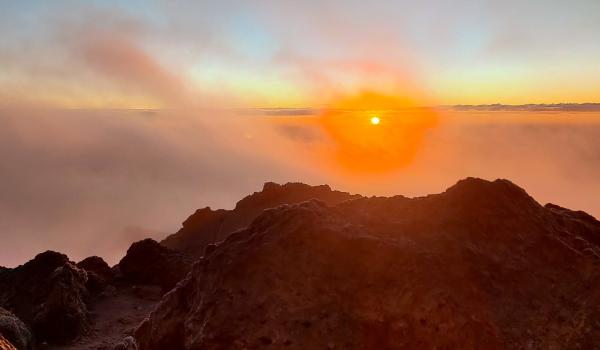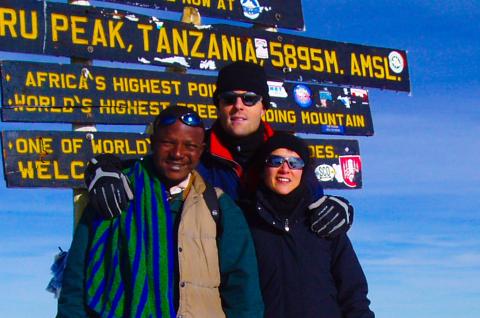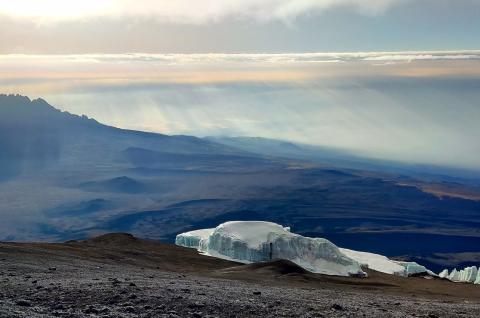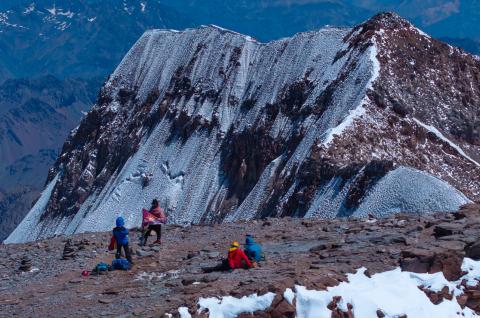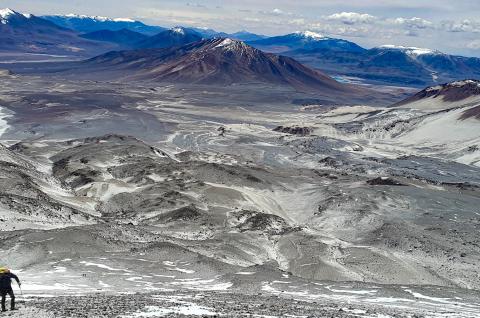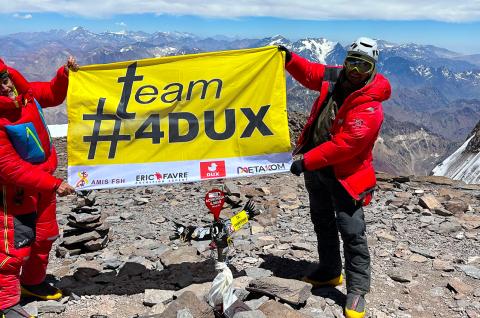A magnificent and wild nine-day climb of the highest peak in Africa with the best acclimatization
Highlights
- 9-day ascent and better acclimatization
- The longest and most beautiful route
- 1 guide for a maximum of 2 participants
- French-speaking local guide on certain dates
- Ifremmont medical hotline H24
- Live expedition coverage with Garmin InReach
- Small groups of 2 to 12 participants
- All the know-how of a high-altitude leader
The Great Traverse of Kilimandjaro offers a complete ascent via the western, northern, eastern and southern slopes. Although expensive and rarely offered, this itinerary stands out for its low number of climbers and more moderate daily vertical drops (500 to 700 metres), thus increasing the chances of success. The ascent leads to Gilman's Point, where you join the classic routes from the south side. The scenery is spectacular, with views over the Kenyan plain and Mawenzi. This is the ideal option for a quiet, less crowded ascent of Kilimanjaro. Communication device and H24 hotline included.
Overview
We take you on board for the Grande Traversée du Kilimandjaro. Approach from the western slope at the foot of the Shira volcano (3962 m), full traverse of the northern slope to approach Mawenzi (5149 m) before ascending the slopes of Kibo (5895 m) and descending the southern slope. Although the trails are of good quality, this itinerary is rarely offered, due to its high cost. Yet it has many advantages. First and foremost, it's not very popular, as the route common to almost all the circuits can be reached only by arriving at Gilman's point, the compulsory crossing point for entering the caldera. The fact that the daily gradients are lower than on any of the other routes increases the chances of success. Each day we climb between five hundred and seven hundred metres, compared with over a thousand on other routes. On the last day to the summit, instead of the 1,300 metres of other routes, there are 1,100 metres left to climb. The scenery is breathtaking: to the north, over the Kenyan plain, to the east over the Mawenzi. This Grande Traversée is by far the least frequented and, in many ways, the best option for climbing Kilimanjaro in total peace and quiet.
As is customary in East Africa, particularly in Tanzania, Kenya and Uganda, entry fees for parks, campsites, community taxes and wild life fees are not included in the sale price. These taxes represent €980 to date, and will be invoiced to you at the time of registration.
And discover our animated Kilimanjaro ascent itinerary.
Itinerary
DAYS 1 & 2 : EUROPE — KILIMANJARO AIRPORT — MOSHI
Day 1
Departure from Europe on Day 1, generally with one day or night devoted to the flight. If we land in the evening, sometimes late, we shall need to plan an extra night at our accommodation. We are met at the airport and transferred to Moshi to reach our lodge: we settle into our accommodation in the garden in the shade of Kilimanjaro's formidable forest, a luxuriant forest which acts as a real sponge, absorbing rainfall.
On day 2, we meet our guide for a briefing, check and prepare our equipment and backpack for the ascent that starts the next day.
JOUR 3 : LEMOSHO GATE (2100 M) — BIG TREE (MKUBWA) CAMP (2780M)
Day 3
Transfer by road from Moshi (or Arusha) to Lemosho Gate. After registering with park services, we continue on the motorized track to the trailhead. The trail starts in the rainforest. It's best to be careful where you set foot, as the many roots form trap doors. The plant cover is dense and the flora varied (if there is no fauna, it has long since disappeared, having been hunted by the natives). In the afternoon, it's not unusual to walk in the rain, common at these altitudes, which makes the path slippery.
DAY 4 : BIG TREE (MKUBWA) CAMP (2780M) — SHIRA ONE CAMP (3505 M)
Day 4
This morning, we quickly leave the forest cover. The path is steep. The dense vegetation gradually fades, giving way to heather and moorland with endemic flora characteristic of the volcano's flanks. The path joins the Shira plateau, which lies at the foot of the Shira cone (3962 metres), the third of Kilimanjaro's volcanic cones. It's hardly noticeable, so much so that our eyes are drawn to the Kibo (the main cone). We cross the Shira Plateau amidst giant ragwort to reach our camp.
DAY 5 : SHIRA ONE CAMP (3505 M) — SHIRA TWO CAMP (3845 M)
Day 5
A day of gentle climbing on the Shira Plateau, amidst the astonishing vegetation. A detour to Shira Cathedral (3880 m) completes our acclimatization. Not a real cathedral, of course, but a geological formation on the western slopes of Mount Kilimanjaro, a colossal tower of lava rock. Similar to the Lava Tower we'll be approaching later, but much larger. The cathedral's name comes from its appearance. Its imposing spires and impressive buttresses evoke the grandeur of a medieval cathedral. Shira is the third of Kilimanjaro's volcanic cones. It has been shaped by lava and volcanic activity to create a stunning jagged peak, offering a unique western view of Kibo, the highest of the peaks and your final destination on the tour.
DAY 6 : SHIRA TWO CAMP (3845 M) — MOIR CAMP (4140 M)
Day 6
Today, we follow a steady rhythm along the edge of heather and moorland, then across a desert area. The detour to Lava Tower is a long detour. We prefer the ascent of Lent Hill (4630 m), which is a round trip from Moir Hut. This detour can also be made at the beginning of the following day, but given the length of the stage to come, it's better to do it on this day. At Moir Hut, the long traverse on the north side of the Kibo really begins. Moir Hut is completely isolated from the south face route. It is a unique lookout point on the north face of the volcano.
DAY 7 : MOIR CAMP (4140 M) — POFU (BUFFALO) CAMP (4030 M)
Day 7
From the camp, a short, slightly steep climb over an old lava flow. The slope eases and we begin the long traverse around the northern slope of Kibo. There are very few visitors on this side of the mountain. The path winds between eruptive boulders. Not much of a climb today, but quite a distance (+/- 12 km) to reach Buffalo camp in the late afternoon. On this day, the view of the plains north of Kilimanjaro, the border and Kenya's famous Amboseli National Park is simply breathtaking.
DAY 8 : BUFFALO CAMP (4030 M) — THIRD CAVE CAMP (4300 M)
Day 8
Last day of the traverse of the north side of Kibo. The trail forks sharply to the east, and we resume our ascent. The vegetation becomes increasingly sparse, giving way to slag, which is hard to walk on. Fortunately, this is offset by the magnificent views of the nearby Mawenzi (5149 m), which is suitable for mountaineers. The camp is located near caves in which the porters take shelter.
DAY 9 : THIRD CAVE CAMP (4300 M) — SCHOOL HUT CAMP (4760 M)
Day 9
Vigil of arms. A short but steep final stage on the slopes of Kibo, amidst a lunar setting worthy of Lord of the Rings. The trail through the scree is unencumbered by switchbacks. The camp is located between large blocks of lava or basalt, with two bad tin huts providing precarious shelter for the porters. Our tents are set up as best we can on makeshift terraces, so it's not exactly comfortable. But the view rewards us for our efforts. Tonight marks our departure for Uhuru Peak, the summit of Kibo (Kilimanjaro).
DAY 10 : KILIMANDJARO SUMMIT — UHURU PEAK (5895 M) — MILLENIUM CAMP (3820 M)
Day 10
Night-time departure around midnight to reach the summit of Kilimanjaro. The path climbs steeply, zig-zagging up the scree slope. Progressing at night in this terrain is an advantage: you can only see the few meters ahead of you. With the first light of dawn, the climb becomes more rewarding. From an altitude of 5,000 metres, a grandiose panorama is revealed of the imposing cone of Mawenzi and Mount Meru, gently lit by the rays of the rising sun. The Tanzanian plain is drowned in a sea of clouds, from which only the points of the various volcanic cones emerge. As the clouds begin to dissipate, lakes Manyara and Eyasi come into view. The climb is tough, our breathing is short and we make slow progress. The trail joins the classic ascent followed by the Marangu and Rongai routes to the rim of the summit crater at Gilman's point (5756 m). A steep path follows the crater rim (into which we do not descend). At Stella Point (5740 m) we meet up with the trekkers from the Machame and Lemosho routes. Another few hundred metres along the rim of the caldera and we're at Uhuru peak (5,895 m), the summit of Kilimanjaro. After an hour, it's time to head for the descent. At Stella Point, we plunge straight down to Barrafu camp, skirting the remains of the tabular Ratzel and Rebmann glaciers. Short rest stop at Barrafu camp (4,640 m). We resume the long descent to reach Millenium camp (3820 m).
DAY 11 : MILLENIUM CAMP (3820 M) — MWEKA GATE (1680 M) — MOSHI
Day 11
Last day of descent through the forest to Mweka camp (3080 m) then Mweka Gate (1830 m), where we receive our climbing certificates: a great moment! Check-in at the hotel. Siesta and pool or stroll: either to the colorful market in town, or through the plantations and food crops of the Chagga region, whose inhabitants have laid out irrigation canals to grow bananas, beans, flowers, coffee, millet, cabbage, tomatoes, corn...
DAY 12 : MOSHI — KILIMANJARO AIRPORT
Day 12
Return to Kilimanjaro Airport for a visit and some final shopping in the handicraft stores (fabrics, paintings, batiks and naive paintings, African hats, T-shirts and shirts, animal and warrior statuettes, jewelry, etc.). Boarding and departure for Europe.
DAY 13 : ARRIVAL IN EUROPE
Day 13
END OF EXPEDITION
For reasons that cannot be foreseen at this stage, such as unpredictable weather, the physical fitness or lack of fitness of participants or other circumstancess (customs formalities, road conditions, traffic, landslides, force majeure, etc.), your expedition leader may have to adapt the program, if necessary, to ensure the smooth running of your trip. He remains the sole judge and the one who guarantees your safety. Activity times are given as an indication and may vary from one participant to another.
The itinerary for all our expedition programs, or the ascent program for our high-mountain expeditions, are given here as a guide only. They are flexible enough to adapt to weather conditions with a few contingency days. In any case, you should follow the recommendations of your guide, who may suggest that you cancel your expedition due to weather, safety or physical conditions.
It is important to remember that this is a truly unsupported expedition, and that anything can happen. Expeditions Unlimited, your expedition leader, your guide or our local teams can in no way be held responsible.
Any costs incurred as a result of a change in the expedition schedule (extra nights' accommodation, extra flights) will be borne by the participants and not by the organizers. "Contingency days" refer to the expedition in the strict sense of the term (base camp/base camp in the mountains, departure point/exit point on a traverse, etc.).
Any early return of the expedition or of certain members only (early success, abandonment, etc.), generating costs for accommodation, meals, changes to air tickets or other activities not provided for in this program, will be charged in full to the participants.
Trip notes
Guiding
YOUR GUIDE ON THE MOUNTAIN
To ensure the success of your Kilimanjaro ascent, we use a ratio of one English-speaking guide for every two participants. Trained by our local teams and with extensive mountain experience, our guides will accompany you during the key moments of the climb and on summit day. On certain dates, we offer a French-speaking guide/translator on some departures (check dates with us).
THE REST OF THE LOCAL AND INTERNATIONAL TEAM
For this climbing project, our local English-speaking team is particularly well-equipped to deal as effectively as possible with the two problems of an expedition: technical supervision and the carrying of equipment (food, collective and personal equipment). This is an important issue, as it directly affects everyone's success.
A kitchen team will be present, as well as a team of porters who will help us set up the camps with all collective and individual equipment and cooking facilities.
Each participant is responsible for carrying his or her own personal belongings and high-altitude food. Collective equipment is carried by the Tanzanian team. A porter carries 15 kilos of your personal belongings, and you carry the rest, ideally in a rucksack weighing no more than 8 to 12 kilos. In other words, don't carry too much!
And all along the climb, we will be relying on other local skills as needed. Finally, we will have access to a high-altitude doctor from Ifremmont (see above).
For unpredictable reasons at this stage, like adverse weather conditions, insufficient physical condition of participants, insufficient competencies of participants related to the intended activities, your guide may decide to adjust the intended program and/or activities. At all times, his decision will be final on all matters likely to affect the safety and well-being of the trip.
Difficulty level
Level rated: challenging
This program is designed for participants who take part in a regular sports activity several times a week, including endurance activity.
This ascent requires excellent physical and mental fitness, as well as experience of walking in mountainous terrain. It is accessible to anyone capable of walking in the mountains for 8 to 12 hours at a normal pace. For the final ascent (Uhuru Peak at 5895 m), a long 15-hour day is required at a very moderate pace, as is always the case at altitude. Trailers will have to slow down to give themselves a chance of success under safe conditions! Our teams will do everything in their power to help you achieve it in the best possible conditions. A summit not to be underestimated in terms of altitude acclimatization.
The natural environments crossed are beautiful and diverse, the trails are sometimes barely marked and the climatic conditions can be testing (hot and humid at the start, low temperatures towards the summit down to -20°C). Above all, participants should be aware of the risks inherent in altitude, particularly hypoxia (acute mountain sickness). The climb itself doesn't require any technical skills, but it does demand a sustained and lengthy effort in sometimes harsh conditions. A porter carries 15 kilos of your personal belongings, and you carry the rest, ideally in a rucksack weighing no more than 8 to 10 kilos. In short, don't carry too much.
To register for this expedition, you will be asked to provide an expedition (montaineering climb list)/trek/sportsman CV. A medical certificate stating that you are not contraindicated in climbing at high altitude is also required for people over 65.
For the duration of your expedition, you will benefit free of charge from membership of the H24 7/7 high-altitude medical service set up with our partner Ifremmont. See below.
Compagnies aériennes internationales
For international transport, regular economy class flights on the following airlines: British Airways, Turkish Airlines, Ethiopian Airlines, etc.
Accommodations
During the expedition, a single tent is provided for you, but sometimes logistics do not allow for this, so you have to agree to sleep in a double tent, which is advantageous in terms of safety (mutual surveillance during the night for acute mountain sickness).
If you are a couple, then accommodation is in a double room, and if availability allows at the lodge where the group meets, we will upgrade you! In double tents during the expedition.
Meals
You are on full board. Breakfast and dinner most often in lodge, lunches at the restaurant on the road or picnics.
Water: provide tablets (type Micropur or other) to disinfect the water you put in your water bottle, according to the source and on the advice of your guide. You can also buy mineral water on site (not included in the price), but its ecological balance is poor, as you know. So we don’t advise you to.
Transfers / Transport
The road trips are planned in private vehicle 4x4 safari with sunroof.
Group size
The group is composed of 2 to 12 participants maximum. The number of participants is deliberately limited to allow for greater immersion, to avoid embarrassing our hosts, and to develop freedom and flexibility. However, the maximum number may be exceeded if the last person to register wishes to travel with one or more other people. The services will not be modified, and the conditions of the trip will remain the same.
Equipment
Personal equipment is not provided. However, a complete list is provided to allow you to check that you are taking what is necessary.
The road trips are planned in private 4x4 safari vehicle.
Personal equipment is not provided. A complete list is provided so that you can check that you are taking what you need.
On the whole in Kilimanjaro, crampons are not required on any of the routes, and a good pair of hiking boots with a good grip is sufficient. However, in recent years, the weather has become quite unpredictable and crampons, even for forestry purposes, can be useful. So, if you have crampons and cramponable boots, take them with you. If not, check with your guide during the briefing on arrival to see if you need them, and it will be possible to rent them on site for a few dozen dollars, depending on conditions.
All collective equipment is provided.
You have a Garmin InReach beacon, enabling you to communicate with your community at your convenience and in an unlimited way during the expedition, and allowing them to follow you live, if you wish! We also provide you with a satellite phone to contact the Ifremmont medical hotline if necessary.
For this electronic equipment, which we make available to you free of charge, we ask you to pay a deposit of €1,500 by cheque (not cashed) or a deposit by credit card / bank transfer, which is cashed and returned when the equipment is returned in the condition in which it was sent to you (you are responsible for the cost of sending back the equipment to the office).
We can also rent you a sleeping bag and any other technical equipment you may not have. Please do not hesitate to contact us.
Our commitments to sustainable development
Our commitment to a better planet has been a reality since the beginning of our story but we always need to do more and better. Please find out more about our charter and our commitments in terms of sustainable development. We have drafted our charter and take action through six themes on which we act as concretely as possible, most often with you: social equity and cultural respect, preservation of water, waste management in expedition, protection of biodiversity, raise public awareness on these subjects and finally, the optimization and recovery of CO2 emissions.
Regarding carbon emissions, most of which are due to air travel, we calculated and communicated in 2018 on the carbon footprint of each of our programs, expressed in tonnes of CO2.
These calculations made us aware of the importance of the total carbon emissions generated by our activity. Also, we have committed in 2022 to a carbon reduction that we believe is unprecedented in the tourism industry, aiming to reduce the total emissions of our activity by 5% per year, taking 2019 as the reference year (3,430 tonnes of CO2). This commitment is in line with the trajectory of the Paris climate agreements of 2015, the current benchmark. Thus, in 2030, we commit ourselves not to exceed 2,160 tonnes of C02. Thus, our maximum “carbon” budget for 2024 is 2,950 tonnes and for 2025, this budget will be reduced to 2,800 tonnes. And so on until 2030. To find out more about all of our calculations and our commitments in terms of reducing our carbon emissions.
In addition, since 2019, we have been encouraging you when you book for your journey to contribute with a donation to an independent NGO, among the two we have selected that share the commitments made in our charter. We matched the amount of this donation to this program's carbon footprint. Thus, the journey you are considering generates 2,67 tons of CO2, which corresponds to a 100% donation of €80 for an estimated value today of €30 per tonne of CO2. This donation remains of course optional and you can decide to give between nothing and 100% of this amount. Since 2019, including covid years of 2020 and 2021, we have been able to collect thanks to you nearly €7,000 for these associations.
Please do not hesitate to come back to us with any questions you might have regarding this carbon footprint mechanism, our other sustainable développement commitments or even to share with us your experience through a chat or a mail at contact@secret-planet.com.
Extensions
Safaris and the Great Migration in the Serengeti
This extension is illustrative. Everything in this program can be adapted, whether in terms of duration, level of comfort or luxury of accommodation, etc. Safaris in Tanzania's parks depend on the season... Please do not hesitate to consult us.
DAY 1: Departure for MANYARA NATIONAL PARK
Departure for nearby Lake Manyara to set up camp at the campsite. This park is renowned for the richness of its biotopes, stretching from the lake to the rocky escarpment of the rift. It is named after the euphorbia plant in the Maa language, a plant used by the Maasai to form enclosures for their cattle. Settle in and take a walk under the guidance of an armed ranger, who will explain his daily routine... for a different approach to the savannah and its wildlife! Then safari drive.
Type of transfer/transport: by private vehicle
Duration of transfer/transport: to be specified according to arrival
Meals: breakfast in hotel – picnic lunch – dinner in camp
Accommodation: night in a camp
DAY 2: MANYARA – SERENGETI NATIONAL PARK
Transfer to Serengeti, which with its 15,000 km2 is one of the world's greatest wildlife sanctuaries, particularly during the period of migration of the large herds. "En route" safari through the "Siringet" savannahs and setting up camp in the heart of this exceptional area: the choice of our camp and our itineraries depends on the movements of the herds.
Transfer/transportation: by private vehicle
Duration of transfer/transport: approximately 5 hours
Meals: breakfast in self-catering camp – picnic lunch – dinner in self-catering camp
Accommodation: night in a camp
DAY 3: SERENGETI SAFARI
A day entirely devoted to the Serengeti, in search of the great herds of migrating herbivores and their many predators (lions, cheetahs, leopards, hyenas, crocodiles...). Our target: the wild animals on the lookout for the dreamlike spectacle of the seasonal migration of hundreds of thousands of antelopes in search of pasture, zebras and above all 1.5 million wildebeest, those astonishing ungulates with the mane of a horse and the horns of a bull.
Meals: breakfast in self-catering camp – picnic lunch – dinner in self-catering camp
Accommodation: night in camp
DAY 4: SERENGETI – N'GORONGORO CRATER
Morning safari in search of the Serengeti's big cats, navigating this ocean of grassy savannah from kopje to kopje, these rocky inselbergs of granite boulders serving as observation posts for the predators. Brunch at the camp and return to the N'gorongoro in the afternoon, depending on our observations. Our camp is set up close to or exactly on the crest of this formidable crater, 700 meters deep and twenty kilometres in diameter: at the heart of the N'gorongoro Conservation Area, a unique site in the world covering 6,500 km2, under the protection of the N'gorongoro Conservation Area and listed by Unesco as one of the world's heritage treasures.
Type of transfer/transport: private vehicle
Duration of transfer/transport: approximately 4 hours
Meals: breakfast in self-catering camp – picnic lunch – dinner in self-catering camp
Accommodation : night in a camp
DAY 5: N'GORONGORO CRATER - TARANGIRE NATIONAL PARK
Careful descent by all-terrain vehicle into the heart of the N'gorongoro Crater for a safari in the middle of this veritable Noah's Ark, where all the animals of Africa's great fauna seem to have gathered (6 hours authorised in the crater). Continuation to Tarangire in the afternoon, a national park renowned for its landscapes dominated by gigantic baobabs and its elephants. We set up camp and embark on our first safari in search of herds of buffalo, zebra, impala and Cape eland. Overnight in a bivouac above the Tarangire River, where there is nothing to separate us from the wildlife: we listen out for the cackles of hyenas and the roars of wild animals on the prowl...
Transfer/transportation: private vehicle
Meals: breakfast in a camp – picnic lunch – dinner in a camp
Accommodation : night in a camp
DAY 6: return from TARANGIRE
Morning safari in Tarangire, brunch and return to Kilimanjaro Airport (2h30 drive) or Nairobi (depending on flight schedule) for a visit and some final shopping in the craft shops (fabrics, paintings, batiks and naive paintings, hats, T-shirts and African shirts, animal and warrior statuettes, jewellery, etc.). We continue our journey.
Type of transfer/transport: private vehicle
Duration of transfer/transport: to be specified according to destination
Meals: breakfast in a camp – lunch on your own (not included) – dinner on the plane
Accommodation: overnight on the plane
Extension duration
6 extra days.
Extension price
Price with minimum of 2 participants, to be agreed upon with our team.
Perfumes of Zanzibar
This extension is illustrative. Everything in this program can be adapted, whether in terms of duration, level of comfort or luxury of accommodation, etc. Zanzibar is an exciting island with beautiful beaches, but paradise lies on Mafia Island... Don't hesitate to contact us.
DAY 1: KILIMANJARO - ZANZIBAR
We are transferred to the Kilimanjaro International Airport, (30 minutes drive from Moshi) to take our flight to Zanzibar. Upon arrival at the airport of Zanzibar, we are met by our driver and transferred to our hotel. Accommodation for 4 nights with half board. In the evening, free time to enjoy our hotel’s facilities or visit the surroundings of our hotel.
This extension is illustrative. Everything in this program can be adapted, whether in terms of duration, level of comfort or luxury of accommodation, etc. Zanzibar is an exciting island with beautiful beaches, but paradise lies on Mafia Island... Don't hesitate to contact us.
Transfer/transportation mode: private vehicle, domestic flight, private vehicle
Transfer/transport time: 1 h
Meals: Breakfast at camp – lunch free (not included) – dinner in hotel
Accommodation: night in hotel
DAY 2: ZANZIBAR
After breakfast, free day. Activities may be offered as an option (see below). options: navigation and snorkeling in the lagoon, scuba diving, boat ride with glass bottom, water sports, swimming with dolphins... check us out!
Meals: breakfast at hotel – lunch free (not included) – dinner in hotel
Accommodation: night in hotel
DAY 3: ZANZIBAR - excursion to mnemba island
After breakfast, we meet our driver at the hotel. Our driver takes us to the port to board a traditional boat. We go for a day of snorkeling on the island of Mnemba: a real small paradise in the archipelago of Zanzibar. The small island of Mnemba is located to the east of the main island of the archipelago, Unguja. Mnemba is only 3 kilometers from the main island of Zanzibar. Despite its small size, you can not get bored on this little paradise surrounded by turquoise water! Snorkeling, diving, relaxing, walking or dhow trip, there are many activities during a stay on Mnemba Island. Seafood lunch included. At the end of the day back to Zanzibar at our hotel.
Transportation: by private vehicle
Meals: breakfast – lunch during the tour – dinner in hotel
Accommodation: night in hotel
Activity: Mnemba Island Tour – lunch included – A/R transfer by boat and private vehicle included
DAY 4: ZANZIBAR – STONE TOWN AND PRISON ISLAND TOUR
After breakfast, we meet with our driver at the hotel that will take us to visit the historic district of Zanzibar listed as a Unesco World Heritage Site and the first natural attraction of this tour to Stone Town and Prison Island. We discover the current culture and history of Stone Town by passing through its attractions, including a Portuguese fort, the sultan’s palace and the birthplace of Freddie Mercury, before continuing our visit to Prison Island, famous for its population of giant turtles. We learn about the long history and many cultural influences that have created Stone Town as it is today and visit the giant turtle colony on Prison Island. At the end of the day, return to our hotel.
Transportation: by private vehicle
Meals: breakfast – lunch free (not included) – dinner in hotel
Accommodation: night in hotel
Activity: Stone Town and Prison Island tour – National Park entrance – A/R transfer by vehicle included
DAY 5: ZANZIBAR – EUROPE
After breakfast, free time according to our flight schedule. Transfer to the airport of Zanzibar to take our flight to Europe.
Transportation: by private vehicle – international flight
Meals: breakfast in hotel – lunch free – dinner on the plane
Extension duration
5 extra days.
Extension price
Price with minimum of 2 participants, to be agreed upon with our team.
Departures and pricing
Please find below all dates and prices for this expedition. Prices are quoted "from" and may be adjusted notably according to the number of participants (see trip notes for details). Please note that dates and prices for years beyond 2024, when given, are for guidance only and are subject to change and readjustment to take account of current economic realities.
No date works for me!
I initiate a new datePrice includes
- Return airport/hotel transfers at Kilimanjaro airport - Moshi
- transfers by private vehicle between Moshi and the start/return point of the expedition
- 2 nights at Chanya lodge (or similar) in Moshi, on a bed and breakfast basis (sharing for even-numbered groups + 1 single room for odd-numbered groups)
- Farewell meal on the last evening in Moshi
- Full-board meals prepared by our cook during the expedition
- Boiled drinking water during the trek (from 1ᵉʳ camp onward)
- Trained, certified and experienced English-speaking mountain guide(s) for a ratio of 1 to 2 participants maximum
- Local team for tent maintenance and camp set-up
- 1 trained and experienced cook and assistant
- 1 porter per person during the expedition (max. 15 kg / pers.)
- 1 rubberized backpack, approx. 100 liters, in which you can store your belongings during the trek. Excellent protection against the rain.
- Single tent (when possible) / double tent for a couple during the expedition
- Four-season tent (shared for even-numbered groups + 1 single tent for odd-numbered groups)
- 1 mattress per person
- Camp equipment: kitchen tent, mess tent, tables and chairs, toilet tent
- Portable toilet tents (1 tent for a maximum of 5 people) Toilet rolls
- 1 hand-washing basin provided
- Collective equipment required for the climb
- Insurance for guides (evacuation, hospitalization, medical expenses, life insurance), cook and helpers
- French-speaking guide/translator on some departures (check dates with us)
- Satellite telephone (for emergency use only)
- Luggage storage during the trek
- 1 emergency oxygen cylinder for 5 participants and a first-aid kit
- Twice-daily health checks with guides and high-quality medical oximeter
- Contribution to the Kilimanjaro Porters Assistance Project: monitoring of Kilimanjaro treks to ensure fair standards of treatment.
- Medical monitoring by Ifremmont during the expedition (see above).
- Live tracking of the expedition for your community (supply of InReach beacon & subscriptions)
- Unlimited text messages to your loved ones (InReach beacon)
- Videoconference preparation meetings in France
Price does not include
- International return flight to Kilimanjaro airport
- Consular fees (visa)
- Any customs taxes upon arrival in Tanzania
- Any import taxes for satellite phones, professional communications equipment and commercial filming
- Additional hotel nights (over 2 nights)
- Pre/post-expedition meals other than those mentioned in the program
- Expenses related to shifts in the expedition schedule (additional nights' accommodation beyond 2 nights, meals, air supplements)
- Expenses related to the early return of the expedition or of certain members only (abandonment, etc.), generating costs for transfers (porters, guide, vehicle, plane, etc.), accommodation, meals, changes to plane tickets or other activities not included in the program.
- Gratuities for guides and local staff, to be shared with other participants to your satisfaction (allow US$200-300, see below).
- Entrance fees for parks, campsites, community taxes, wild life fees (€980 invoiced on registration).
- Any personal communications by satellite phone (unless expressly agreed otherwise)
- Deposit of €1,500 for the loan of electronic equipment, returned in the condition in which it was provided (return postage at your expense).
- Pre-acclimatization protocol developed with Ifremmont and physical and/or mental preparation with a specialist Sport Altitude coach as described above.
- Drinks and all personal expenses (personal visits, cabs, souvenirs, dry cleaning, etc.).
- Travel and expedition insurance (assistance, evacuation and repatriation)
